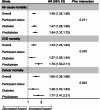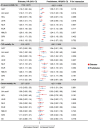Oxidative stress and inflammation mediate the adverse effects of cadmium exposure on all-cause and cause-specific mortality in patients with diabetes and prediabetes
- PMID: 40158078
- PMCID: PMC11954339
- DOI: 10.1186/s12933-025-02698-5
Oxidative stress and inflammation mediate the adverse effects of cadmium exposure on all-cause and cause-specific mortality in patients with diabetes and prediabetes
Abstract
Background: The effect of cadmium exposure on mortality risk among individuals with diabetes and prediabetes remains unclear, particularly regarding potential mediation by oxidative stress and inflammation. This study aimed to investigate the associations of blood cadmium levels with all-cause, cardiovascular disease (CVD), and cancer mortality and the mediating effects of oxidative stress and inflammation biomarkers in patients with diabetes and prediabetes.
Methods: In this prospective cohort study, we analyzed 17,687 adults with diabetes and prediabetes from the National Health and Nutrition Examination Survey (NHANES, 1999-2018). Nine biomarkers related to oxidative stress (gamma-glutamyl transferase [GGT], uric acid [UA], high-density lipoprotein [HDL], UA to HDL ratio [UHR]) and inflammation (neutrophil-lymphocyte ratio [NLR], monocyte-lymphocyte ratio [MLR], neutrophil-monocyte-lymphocyte ratio [NMLR], systemic inflammation response index [SIRI], systemic immune-inflammation index [SII]) were systematically assessed. Kaplan-Meier survival analysis, Cox proportional hazards models, and restricted cubic splines (RCS) were applied to evaluate the association of cadmium with mortality risk. Generalized linear models were used to assess the association of cadmium with oxidative stress and inflammation biomarkers, while Cox regression and RCS evaluated their effects on mortality. Causal mediation analysis identified biological pathways mediated by oxidative stress and inflammation. Stratified and sensitivity analyses were further employed to confirm the robustness of the results.
Results: During 161,047.75 person-years of follow-up, 3562 deaths occurred, including 1214 from CVD and 680 from cancer. Higher blood cadmium levels were associated with increased risks of all-cause mortality (fully adjusted hazard ratio [HR]: 2.17; 95% confidence interval [CI] 1.69-2.79, comparing highest vs. lowest quartile), CVD mortality (HR 2.06; 95% CI 1.41-3.02), and cancer mortality (HR 2.38; 95% CI 1.47-3.85), without evidence of nonlinear relationship. Mediation analyses indicated that UA, NLR, MLR, NMLR, and SIRI partially mediated the associations of cadmium with all-cause and CVD mortality, although the mediated proportions were relatively modest (ranging from 1.4 to 4.8%). Additionally, GGT mediated a small fraction of the associations with all-cause and cancer mortality.
Conclusion: Cadmium exposure increases the risk of all-cause, CVD, and cancer mortality in patients with diabetes and prediabetes. Oxidative stress and inflammation appear to partially mediate this adverse effect. These findings emphasize the urgent need for targeted interventions to reduce cadmium-related mortality risks.
Research insights: What is currently known about this topic? Cadmium exposure is linked to increased mortality. Oxidative stress and inflammation are critical in diabetes development and complications. What is the key research question? Does cadmium exposure increase mortality risk in patients with diabetes and prediabetes? Are oxidative stress and inflammation involved in mediating these effects? What is new? Cadmium exposure increases all-cause and cause-specific mortality in diabetes and prediabetes. Oxidative stress and inflammation mediate these associations. How might this study influence clinical practice? Monitor cadmium, oxidative stress, and inflammation to reduce mortality in diabetes and prediabetes.
Keywords: Cadmium; Diabetes; Inflammation; Mortality; Oxidative stress; Prediabetes.
© 2025. The Author(s).
Conflict of interest statement
Declarations. Ethics approval and consent to participate: The NHANSE study was approved by the National Center for Health Statistics Ethics Review Board (IRB/ERB Protocol Number of each cycle was available at: https://www.cdc.gov/nchs/nhanes/about/erb.html ). Consent for publication: Not applicable. Competing interests: The authors declare no competing interests.
Figures





References
-
- Echouffo-Tcheugui JB, Perreault L, Ji L, Dagogo-Jack S. Diagnosis and management of prediabetes: A review. JAMA. Am Med Assoc; 2023. pp. 1206–16. - PubMed
-
- Manrique-Acevedo C, Hirsch IB, Eckel RH. Prevention of cardiovascular disease in type 1 diabetes. N Engl J Med. 2024;390:1207–17. - PubMed
-
- Cosentino F, Grant PJ, Aboyans V, Bailey CJ, Ceriello A, Delgado V, et al. 2019 ESC guidelines on diabetes, pre-diabetes, and cardiovascular diseases developed in collaboration with the EASD. Eur Heart J. 2020;41:255–323. - PubMed
-
- Ho NT, Abe SK, Rahman MS, Islam R, Saito E, Gupta PC, et al. Diabetes is associated with increased liver cancer incidence and mortality in adults: A report from Asia cohort consortium. Int J Cancer. 2024;155:854–70. - PubMed
MeSH terms
Substances
LinkOut - more resources
Full Text Sources
Medical
Miscellaneous

